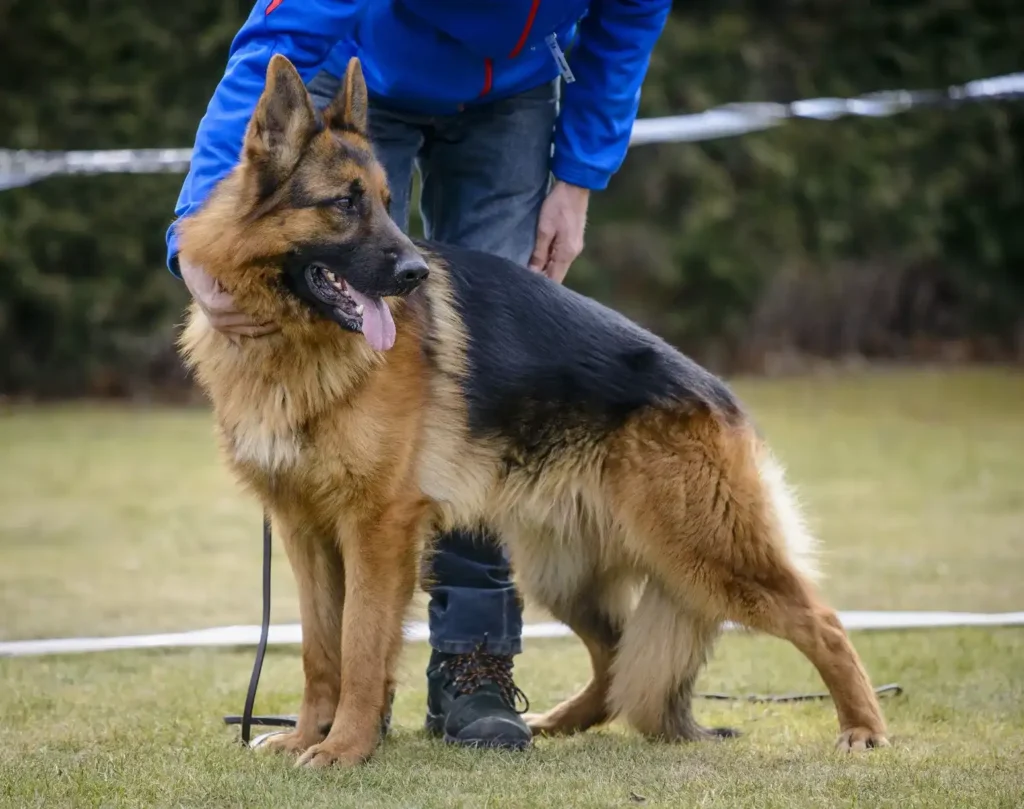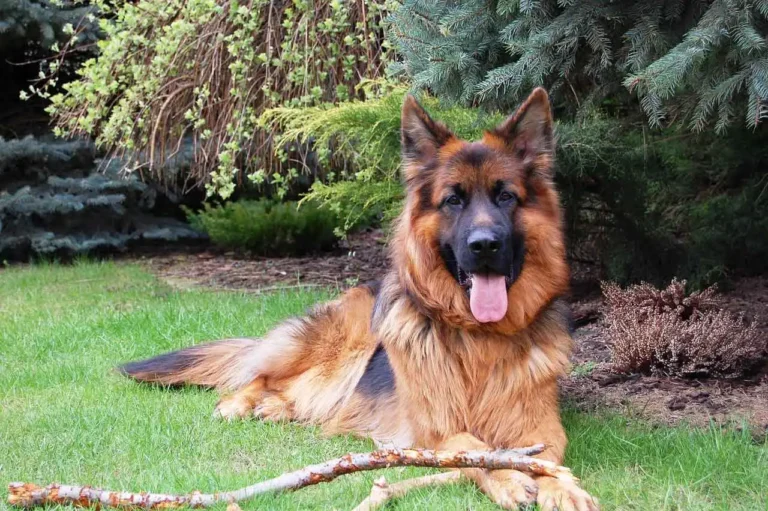Care and maintenance of a German Shepherd
The German Shepherd is the most widespread working dog breed in the world. Thanks to their eagerness to learn and their people-loving personality, these versatile dogs are also well-suited for family life.

Features
Hardly any other breed of dog can be used for as many different purposes as a German Shepherd. Originally, this breed was bred to be a herding dog to look after sheep. Today, German Shepherds are also used as service dogs in the police, military and customs authorities, as rescue and therapy dogs, and as avalanche dogs or guide dogs. This makes the German Shepherd the world’s leading breed among service dogs.
Confident, robust and obedient
Neither humans nor machines can replace the brave, enduring and reliable dogs when they work. The dog’s self-confidence, instinctive behavior and endurance are unparalleled. Due to its high intelligence, eagerness to learn and enormous willingness to work, a German Shepherd dog takes on challenges head on and is suitable for almost any task. In addition, the German Shepherd dog is very fond of people.
It will be faithful, loyal and reliable by its owner’s side at all times. It is especially the combination of robustness, willingness to work, reliability and obedience that makes the German Shepherd so popular and optimally suited for many different tasks.
A working dog as a family dog?
The loyalty and reliability towards humans have also made the German Shepherd a sought-after family dog. In fact, it is a great partner and companion that is well suited to family life, provided that it is well-bred and sufficiently occupied. Well-socialized German Shepherds are child-friendly and work well with other pets. However, a prerequisite for life as a family dog is that this active dog is given enough physical and mental challenges.
Animals that are not given enough to do and whose physical needs and willingness to work are not taken into account often develop undesirable behaviors that are not typical of balanced purebred dogs. They become nervous, suffer from hypervigilance and are difficult to control in everyday life. On the other hand, a German Shepherd that is challenged both mentally and physically will be an enrichment for any family: playmate, sports partner and loyal protector.
Look
With a shoulder height of between 60 and 65 cm in males and 55 to 60 cm in females, the German Shepherd is considered a medium to large breed of dog. Its well-proportioned body reflects its life as a working dog. It is powerful and muscular, but at the same time appears agile and athletic. There is no tendency to clumsy behavior. The dog’s gait is wide and powerful, and testifies to its enormous stamina.
The wedge-shaped head, which is in harmonious proportion to the rest of the body, ends with a straight bridge of the nose and a black nose. It also impresses with its set of 42 teeth. The erect, forward-facing ears and the dark, slightly slanted eyes give the German Shepherd a perpetually alert and attentive expression.
Fur and color variations
For a long time, the breed standard of the FCI, where the German Shepherd is listed as number 166 in the Working, Herding and Herding Dogs group, only allowed German Shepherds with short coats. The coat should lie close and straight against the body and be reinforced by a thick undercoat, which should protect the dog from snow, rain and cold.
The long-haired type was not included in the FCI breed standard until 2008. The long, soft guard hairs, which in this coat type do not lie close to the body, are bushy around the ears, legs and tail. The fur-covered neck shows a typical mane of hair. The coat color is black with brown, yellow or light gray markings, solid black or wolf gray, or gray with brown shades.
White German Shepherd
Although white German Shepherd puppies can occasionally be found in a litter, this colour has been considered a “faulty colour” within the FCI standard since 1933. In 1968, the “Shepherd Dog Club of America” followed suit – which is responsible for the standards of the “American Kennel Club”. The only exception to this is the “Canadian Kennel Club”, which still recognises white German Shepherds in its studbook.
Since 2011, the FCI has listed the “white German Shepherd” as a separate breed under the name “Berger Blanc Suisse”. However, it is not permitted to mate white German Shepherd puppies with white German Shepherds. White German Shepherds cannot therefore be registered under the Berger Blanc Suisse breed.

Breeding of German Shepherds
In general, the German Shepherd has become increasingly stronger and larger over the course of its breeding history. Critics complain that this form has little in common with the original type, which was considerably lighter, less muscular, but at the same time also more supple and agile. The disagreements among the breeders eventually led to the formation of two different breeding schools.
One focused mainly on appearance and so-called show breeding, in which the dog has a more massive body and a sloping, low back. The other preferred the lighter dog type and placed more emphasis on performance and characteristics that highlight the skills of a working and service dog.
History
The ancestors of the German Shepherd probably lived in Germany as early as the 7th century. The short-haired dogs already had a fairly wide range of tasks at that time. Although they were mainly used as herding dogs, guarding the shepherd’s belongings was also a large part of the dog’s responsibilities.
Officially, the history of the German Shepherd as we know it today only begins at the end of the 19th century. In 1871, the Prussian riding master Max von Stephanitz, who is today considered the founder of the breed, began targeted breeding.
German Shepherd – a symbol of German virtues
Stephanitz’s goal was clearly defined. He wanted to breed a versatile working dog, and had very clear ideas about what the nature and working qualities of this dog should look like. The virtues of courage, loyalty, obedience, endurance and robustness made the German Shepherd world-famous and in many countries one of the most popular service dogs for authorities such as the police and the military.
During the First and Second World Wars, these qualities were stylized as “German virtues”, and the German Shepherd became a symbol of National Socialist ideology. In the wake of the anti-German anger abroad, the British Kennel Club changed the breed name to “Alsatian Wolf Dog” or later simply “Alsatian Dog” to avoid the addition of “German” in the name. It was not until 1977 that this was changed back to the original name.
Nevertheless, the German Shepherd was a sought-after war dog – both on the German side and the Allies. The German Shepherd also gained a sad reputation for its efforts in concentration camps and as a faithful companion next to Adolf Hitler.
Numerous pictures from Nazi propaganda show Hitler with his German Shepherd “Blondi”. Despite this and the severe thinning of the breed due to World War II, the breed gained a new foothold and soon became one of the most sought-after working dog breeds worldwide. As a result of many dog breeds being “transformed” into family dogs, the German Shepherd also became increasingly popular as just that.
Breeding and health
With the increasing popularity and spread of breeds, the number of breed-specific diseases has unfortunately also increased. Hip dysplasia (HD), which is also known in a number of other breeds, is also found in the German Shepherd. In addition, elbow dysplasia (AD) and degenerative lumbar spinal stenosis are other joint diseases to which this breed is unfortunately predisposed. In addition, there has also been an increase in the number of eye diseases and allergies in this breed.
You won’t find healthy puppies on offer.
With genetic tests from the animals used for breeding, it is possible to reduce the number of diseases mentioned above. However, there is a so-called breeding score that indicates whether the puppy is predisposed to certain diseases.
Animals that have a strong genetic predisposition to one or more health problems are excluded from further breeding. If you are interested in a German Shepherd puppy, you should definitely check whether the breeder has carried out all recommended tests and whether these have also been passed.
A prerequisite for this is that you buy the puppy from a serious breeder, who invests a lot of time and the necessary financial resources to ensure optimal health. Such a breeder will also be happy to provide you with information about anything you may be wondering about. It therefore goes without saying that a healthy puppy that is cared for in the best possible way cannot be bought on offer or at a “super price”. Compared to other purebred dogs, the price of a German Shepherd purebred dog is still relatively low.
Which breeder is right for me?
Before you decide on a breeder, you should first think about what type of German Shepherd you want to have. Most breeders today specialize in different breeding lines, and thus also promote different characteristics to a greater extent.
This means that it depends on the breed to what extent different characteristics such as the need to work or the characteristic features of the shepherd dog are expressed. Check in advance which breeding line the breeder follows, and choose the one that best suits your ideas and needs. Even if you only want to keep the German Shepherd dog as a family dog, you should be aware that even dogs that originate from such a breeding line still have a very high willingness to learn and a great need to be occupied. They will never be satisfied with a small, short walk.
The nutrition of a German Shepherd
The activity level of the dog is decisive for the nutritional needs and which type of nutrition is most suitable. It is clear that service and working dogs that spend several hours “at work” on a daily basis and move a lot have a completely different energy requirement than family dogs that normally have longer breaks of several hours.
What should not be missing from the diet – regardless of what the dog’s daily routine looks like – are proteins, minerals and vitamins that contribute to healthy development. Meat is the most important source of protein, and should make up approx. 70% of the dog’s diet. The dog can get this in the form of either ready-made food, homemade food or in raw form (so-called BARF feeding). It is also recommended that the dog eats 20-30% fruit and vegetables, so that the dog gets all the necessary vitamins and minerals. Too much grain or sugar does not belong in dog food.
Avoid too rapid growth
Since German Shepherds, like many other large dog breeds, are prone to joint problems, it is important to avoid too rapid growth in the first few months. Research shows that hip dysplasia is not only dependent on genetic predisposition, but is also related to nutrition. A diet with too much energy and fat accelerates the already rapid growth of puppies and can lead to joint problems even when the dog is older.
You should therefore obtain information about your puppy’s nutritional needs and follow the feeding recommendations from the breeder or veterinarian. It is also important not to demand too much from your puppy when it comes to movement. In the beginning, walking up and down stairs should be avoided completely. Natural breaks promote the healthy development of both bones and joints.
Care & maintenance of a German Shepherd
In addition to a healthy diet and species-appropriate dog care, sensible dog care is also essential.to a healthy dog life. The German Shepherd’s coat is quite easy to care for, although regular brushing and coat careis important and necessary to maintain a healthy coat structure. Equally important and indispensable are regular worming and vaccinationsat the vet. In addition, you should also keep an eye on the eyes, ears and claws. These also require some attention and care from time to time and should be examined by a vet if you notice any changes.
Keeping a German Shepherd
If you decide to get a German Shepherd, you should of course not only think about its nutrition and care, but also think about keeping such a purebred dog. German Shepherds are primarily working dogs and want to be treated accordingly, despite being primarily kept as family dogs. Sufficient physical and mental activity is therefore essential for a harmonious life together. As the owner of a German Shepherd, you should not only have time and be happy with long walks and/or bike rides, but also strive to meet the needs of this active and eager-to-learn breed by, for example, practicing a dog sport or some form of education.
Sporty family dog
Thanks to its versatility, this breed is suitable for almost all types of dog sports., such as agility, obedience or Dog Dance. The exceptional sense of smell also makes it excellent for mantrailing and tracking. What is recommended for German Shepherds kept as family dogs is to complete training as, for example, a rescue dog or patrol dog.
Regardless of the activity you choose, you will quickly notice the positive effects that this has on the dog and the relationship between you. Dogs that are sufficiently exercised both physically and mentally can not only enjoy their breaks more, but are also easier to train. Those who spend enough time on training and make sure that the dog gets enough exercise will be rewarded with a lovable, resilient and loyal family dog.







One Comment